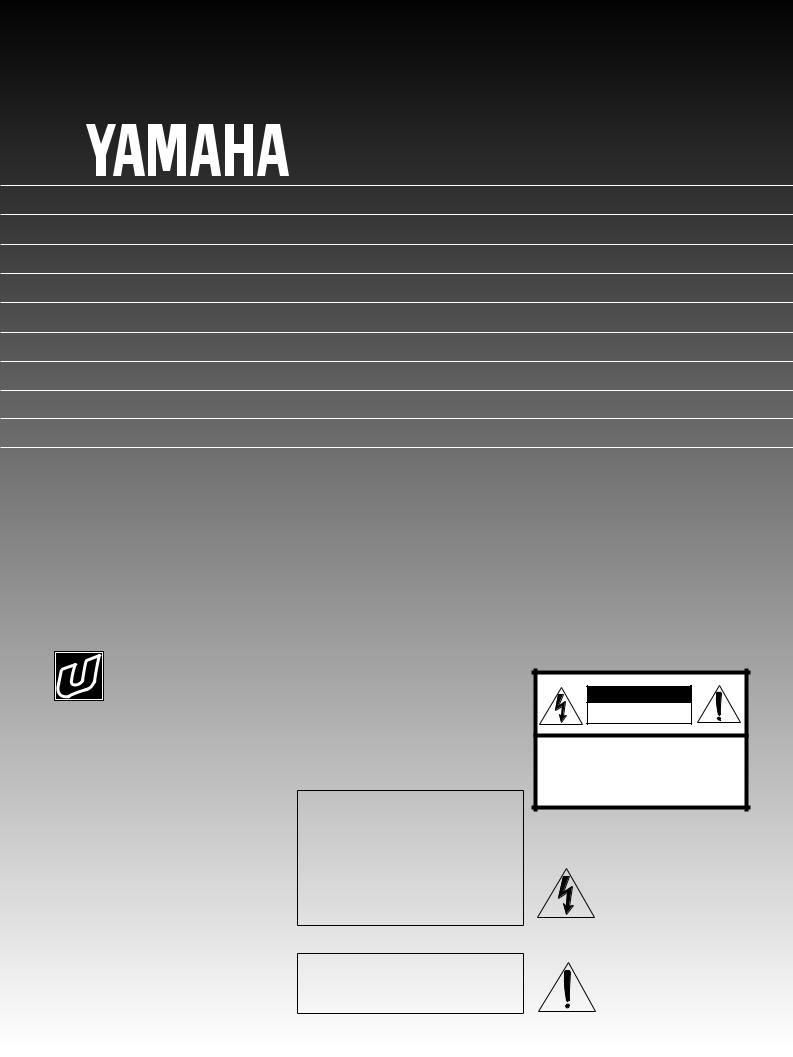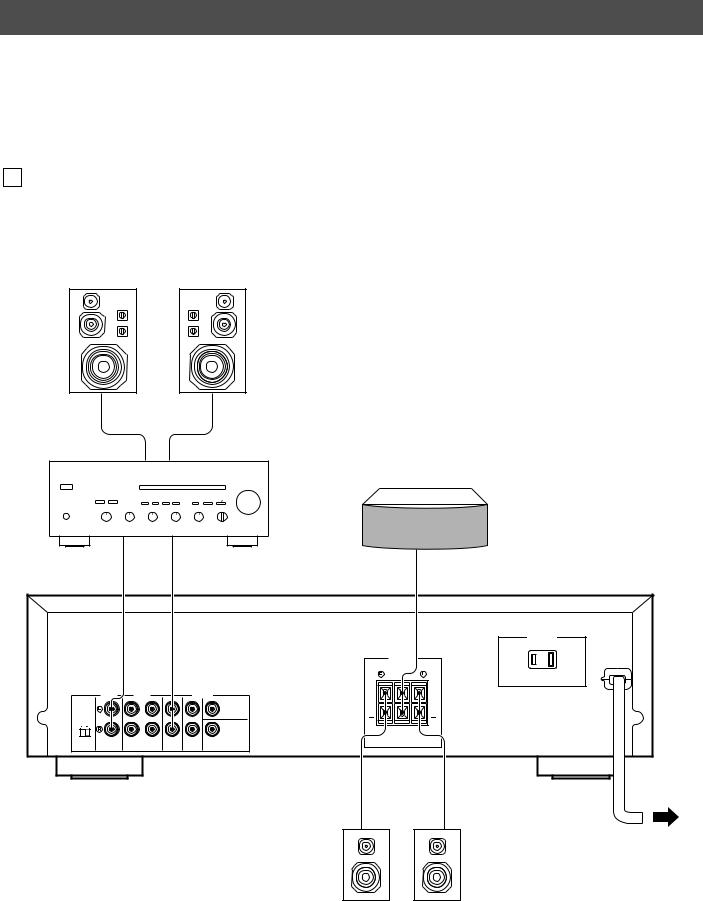Yamaha Audio DSP-E390 User Manual

Natural Sound Digital Sound Field Processor
4 Programs for Digital Sound Field Processing
2 Programs for Dolby Surround (DOLBY PRO LOGIC and ENHANCED)
60W (8Ω ) RMS Output Power, 0.1% THD, 1 kHz (Center Channel Power Amplifier)
15W + 15W (8Ω ) RMS Output Power, 0.7% THD, 1 kHz (Rear Channel Power Amplifier)
Automatic Input Balance Control for Dolby Surround
Test Tone Generator for Easier Speaker Balance Adjustment
3 Center Channel Modes (NORMAL/WIDE/PHANTOM)
Remote Control Capability
Thank you for selecting this YAMAHA digital sound field processor.
OWNER’S MANUAL |
|
CONTENTS |
|
Safety Instructions ................... |
2 |
Supplied Accessories .............. |
3 |
Profile of This Unit .................... |
4 |
Speaker Setup ........................... |
5 |
Connections ............................. |
6 |
Identification of Controls .......... |
9 |
Speaker Balance Adjustment |
|
............................................... |
10 |
Using Digital Sound Field |
|
Processor (DSP) .................... |
12 |
Notes about the Remote |
|
Control Transmitter ................. |
15 |
Troubleshooting ...................... |
16 |
Specifications ......................... |
16 |
IMPORTANT!
Please record the serial number of this unit in the space below.
Serial No.:
The serial number is located on the rear
of the unit.
Retain this Owner’s Manual in a safe place for future reference.
WARNING
TO REDUCE THE RISK OF FIRE OR
ELECTRIC SHOCK, DO NOT EXPOSE
THIS UNIT TO RAIN OR MOISTURE.
CAUTION
R I S K O F E L E C T R I C
S H O C K
CAUTION: TO REDUCE THE RISK OF
ELECTRIC SHOCK, DO NOT REMOVE COVER (OR BACK), NO USER-SERVICEABLE
PARTS INSIDE, REFER SERVICING TO
QUALIFIED SERVICE PERSONNEL.
• Explanation of Graphical Symbols
The lightning flash with arrowhead symbol, within an equilateral triangle,
is intended to alert you to the
presence of uninsulated “dangerous voltage” within the product’s enclosure that may be of sufficient magnitude to constitute a risk of electric shock to persons.
The exclamation point within an equilateral triangle is intended to alert you to the presence of important operating and maintenance
(servicing) instructions in the literature accompanying the
appliance.
Downloaded from: http://www.usersmanualguide.com/

SAFETY INSTRUCTIONS
1Read Instructions – All the safety and operating instructions should be read before the unit is operated.
2Retain Instructions – The safety and operating instructions should be retained for future reference.
3Heed Warnings – All warnings on the unit and in the operating instructions should be adhered to.
4Follow Instructions – All operating and other instructions should be followed.
5Water and Moisture – The unit should not be used near water – for example, near a bathtub, washbowl, kitchen sink, laundry tub, in a wet basement, or near a swimming pool, etc.
6Carts and Stands – The unit should be used only with a cart or stand that is recommended by the manufacturer.
6A A unit and cart combination should be moved with care. Quick stops, excessive force, and uneven surfaces may cause the unit and cart combination to overturn.
7Wall or Ceiling Mounting – The unit should be mounted to a wall or ceiling only as recommended by the manufacturer.
8Ventilation – The unit should be situated so that its location or position does not interfere with its proper ventilation. For example, the unit should not be situated on a bed, sofa, rug, or similar surface, that may block the ventilation openings; or placed in a built-in installation, such as a bookcase or cabinet that may impede the flow of air through the ventilation openings.
9Heat – The unit should be situated away from heat sources such as radiators, stoves, or other appliances that produce heat.
10Power Sources – The unit should be connected to a power supply only of the type described in the operating instructions or as marked on the unit.
11Power-Cord Protection – Power-supply cords should be routed so that they are not likely to be walked on or pinched by items placed upon or against them, paying particular attention to cords at plugs, convenience receptacles, and the point where they exit from the unit.
12Cleaning – The unit should be cleaned only as recommended by the manufacturer.
13Nonuse Periods – The power cord of the unit should be unplugged from the outlet when left unused for a long period of time.
14Object and Liquid Entry – Care should be taken so that objects do not fall into and liquids are not spilled into the inside of the unit.
15Damage Requiring Service – The unit should be serviced by qualified service personnel when:
A.The power-supply cord or the plug has been damaged; or
B.Objects have fallen, or liquid has been spilled into the unit; or
C.The unit has been exposed to rain; or
D.The unit does not appear to operate normally or exhibits a marked change in performance; or
E.The unit has been dropped, or the cabinet damaged.
16Servicing – The user should not attempt to service the unit beyond those means described in the operating instructions. All other servicing should be referred to qualified service personnel.
17Power Lines – An outdoor antenna should be located away from power lines.
18Grounding or Polarization – Precautions should be taken so that the grounding or polarization is not defeated.
Caution: Read this before operating your unit
1To assure the finest performance, please read this manual carefully. Keep it in a safe place for future reference.
2Install this unit in a cool, dry, clean place – away from windows, heat sources, sources of excessive vibration, dust, moisture and cold. Avoid sources of humming (transformers, motors). To prevent fire or electrical shock, do not expose the unit to rain and water.
3Do not operate the unit upside-down. It may overheat, possibly causing damage.
4Never open the cabinet. If something drops into the set, contact your dealer.
5Do not use force on switches, controls or connection wires. When moving the unit, first disconnect the power plug and the wires connected to other equipment. Never pull the wires themselves.
6The openings on the cabinet assure proper ventilation of the unit. If these openings are obstructed, the temperature inside the cabinet will rise rapidly and eventually damage the circuits. Therefore, avoid placing objects against these openings and do not install the unit where the flow of air through the ventilation openings could be impeded.
2
7Do not attempt to clean the unit with chemical solvents; this might damage the finish. Use a clean, dry cloth.
8Always set the VOLUME control to “– ∞ ” before starting the audio source play: increase the volume gradually to an appropriate level after the play back has been started.
9To prevent lightning damage, pull out the power cord during an electrical storm.
10Be sure to read the “TROUBLESHOOTING” section regarding common operating errors before concluding that the unit is faulty.
11AC outlet
Do not connect audio equipment to the AC outlet on the rear panel if that equipment requires more power than the outlet is rated to provide.
Downloaded from: http://www.usersmanualguide.com/

FCC INFORMATION
1. IMPORTANT NOTICE : DO NOT MODIFY THIS UNIT! |
Compliance with FCC regulations does not guarantee that |
|
This product, when installed as indicated in the |
interference will not occur in all installations. If this product |
|
instructions contained in this manual, meets FCC |
is found to be the source of interference, which can be |
|
requirements. Modifications not expressly approved by |
determined by turning the unit “OFF” and “ON”, please try |
|
Yamaha may void your authority, granted by the FCC, to |
to eliminate the problem by using one of the following |
|
use the product. |
measures: |
|
2. IMPORTANT : When connecting this product to |
Relocate either this product or the device that is being |
|
accessories and/or another product use only high quality |
affected by the interference. |
|
shielded cables. Cable/s supplied with this product |
Utilize power outlets that are on different branch (circuit |
|
MUST be used. Follow all installation instructions. |
||
breaker or fuse) circuits or install AC line filter/s. |
||
Failure to follow instructions could void your FCC |
||
|
||
authorization to use this product in the USA. |
In the case of radio or TV interference, relocate/reorient the |
|
3. NOTE : This product has been tested and found to |
antenna. If the antenna lead-in is 300 ohm ribbon lead, |
|
comply with the requirements listed in FCC Regulations, |
change the lead-in to coaxial type cable. |
|
Part 15 for Class “B” digital devices. Compliance with |
If these corrective measures do not produce satisfactory |
|
these requirements provides a reasonable level of |
||
results, please contact the local retailer authorized to |
||
assurance that your use of this product in a residential |
||
distribute this type of product. If you can not locate the |
||
environment will not result in harmful interference with |
||
appropriate retailer, please contact Yamaha Electronics |
||
other electronic devices. |
||
Corp., U.S.A. 6660 Orangethorpe Ave, Buena Park, CA |
||
This equipment generates/uses radio frequencies and, if |
||
90620. |
||
not installed and used according to the instructions |
The above statements apply ONLY to those products |
|
found in the users manual, may cause interference |
||
distributed by Yamaha Corporation of America or its |
||
harmful to the operation of other electronic devices. |
||
subsidiaries. |
||
|
We Want You Listening For A Lifetime
YAMAHA and the Electronic Industries Association’s Consumer Electronics Group want you to get the most out of your equipment by playing it at a safe level. One that lets the sound come through loud and clear without annoying blaring or distortion – and, most importantly, without
affecting your sensitive hearing. Since hearing damage from loud sounds is often undetectable until it is too late, YAMAHA and the Electronic Industries Association’s Consumer Electronics Group recommend you to avoid prolonged exposure from excessive volume levels.
SUPPLIED ACCESSORIES
After unpacking, check that the following parts are contained.
● Remote Control Transmitter |
● Batteries (size AA, R6, UM-3) |
● Audio connection cord x 2
3
Downloaded from: http://www.usersmanualguide.com/

PROFILE OF THIS UNIT
You are the proud owner of Yamaha DSP-E390 – an extremely sophisticated audio component. The Digital Sound Field Processor (DSP) built into this unit takes full advantage of Yamaha’s undisputed leadership in the field of digital audio processing to bring you a whole new world of listening experiences. Follow the instructions in this manual carefully when setting up your system, and this unit will sonically transform your room into a totally new listening environment –movie theater, concert hall, and so on. In addition, you get incredible realism from Dolby Surround-encoded video sources using the built-in Dolby Pro Logic Surround Decoder.
Please read this operation manual carefully and store it in a safe place for later reference.
Digital Sound Field Processing
What is it that makes live music so good? Today’s advanced sound reproduction technology lets you get extremely close to the sound of a live performance, but chances are you’ll still notice something missing: the acoustic environment of the live concert hall. Extensive research into the exact nature of the sonic reflections that create the ambience of a large hall has made it possible for Yamaha engineers to bring you this same sound in your own listening room, so you’ll feel all the sound of a live concert.
Furthermore, our technicians, armed with sophisticated measuring equipment, have even made it possible to capture the acoustics of a variety of venues such as an actual concert hall, theater, etc. to allow you to accurately recreate one of several live performance environments in your own home.
Dolby Pro Logic Surround
The Dolby Pro Logic Surround Decoder program lets you experience the dramatic realism and impact of a Dolby Surround movie theater sound in your own home. Dolby Pro Logic gets its name from its professional-grade steering logic circuitry, which provides greater effective front and rear channel separation for a much higher degree of realism than the “passive” Dolby Surround circuits found in less sophisticated home audio/video equipment. Dolby Pro Logic Surround provides a true center channel, so there are four independent channels, unlike passive Dolby Surround which has in effect only three channels: left, right, and rear. This center channel allows listeners seated in even less-than-ideal positions to hear the dialog originating from action on the screen while getting a stereo effect as well.
This Dolby Pro Logic Surround Decoder employs a digital signal processing system. This system increases sound stability at each channel and minimizes crosstalk between channels compared to conventional analog Dolby signal processing.
In addition, this unit features a built-in automatic input balance control. This circuit always presents you the best surround conditions without performing manual adjustments.
Dolby Pro Logic Surround + DSP
You can also enjoy a combination of Dolby Pro Logic Surround and DSP in the sound field program “ 
 PRO LOGIC ENHANCED”.
PRO LOGIC ENHANCED”.
It recreates the surround effect of a movie theater, effectively duplicating its multiple surround loudspeaker system, completely surrounding the listener with the sounds of the action taking place on the screen.
4
Downloaded from: http://www.usersmanualguide.com/

SPEAKER SETUP
SPEAKERS TO BE USED
This unit is designed to provide the best sound-field quality with a 5 speaker configuration. The most effective speakers to use with this unit are front speakers, rear speakers and a center speaker. You may omit the center speaker. (Refer to the “4-Speaker Configuration” shown below.)
The front speakers are used for the main source sound plus the effect sounds. They will probably be the speakers from your present stereo system. The rear speakers are used for the effect and surround sounds, and the center speaker is for the center sounds (dialog etc.) within the Dolby Surround encoded programs. The center speaker needs to be equal in power to the front speakers, although the rear speakers should not be equal. However, all the speakers should have high enough power handling to accept the maximum output of this unit.
SPEAKER CONFIGURATION
5-Speaker Configuration
This configuration is the most effective and recommended one. In this configuration, the center speaker is necessary as well as the rear speakers. If the digital sound field program DOLBY PRO LOGIC or DOLBY PRO LOGIC ENHANCED is selected, conversations will be output from the center speaker and the ambience will be excellent.
●Set the center channel mode to the “NORMAL” or “WIDE” position. (For details, refer to page 10.)
Front L |
Center |
Front R |
Dialogue
Surround sound
Rear L Rear R
4-Speaker Configuration
The center speaker is not used in this configuration. If the digital sound field program DOLBY PRO LOGIC or DOLBY PRO LOGIC ENHANCED is selected, the center sound is output from the left and the right front speakers. However, the sound effect of other programs can be the same as that of the 5-speaker configuration.
●Be sure to set the center channel mode to the “PHANTOM” position. (For details, refer to page 10.)
Front L |
Front R |
Dialogue
Surround sound
Rear L Rear R
SPEAKER PLACEMENT
The recommended speaker configuration, the 5-speaker configuration, will require two speaker pairs: front speakers (your normal stereo speakers), and rear speakers, plus a center speaker. When you place these speakers, refer to the following.
Front R
Center
Front L
 TV set
TV set
Rear R
Front: In normal position. (The position of your present stereo speaker system.)
Rear: Behind your listening position, facing slightly inward. Nearly six feet (approx. 1.8 m) up from the floor.
Center: Precisely between the front speakers. (To avoid interference with TV sets, use a magnetically shielded speaker.)
Rear L
5
Downloaded from: http://www.usersmanualguide.com/

CONNECTIONS
•Before attempting to make any connections to or from this unit, be sure to first switch OFF the power to this unit and to any other components to which connections are being made.
•When making connections between this unit and other components, be sure all connections are made correctly, that is to say L (left) to L, R (right) to R, “+” to “+” and “–” to “–”. Also, refer to the owner’s manual for each component to be connected to this unit.
•Choose one of the following three ways to connect this unit to your amplifier.
AConnecting to an Integrated Amplifier or Stereo Receiver with PRE OUT and MAIN IN terminals
Front speakers
Left |
Right |
Integrated amp.
Center speaker
PRE OUT |
MAIN IN |
|
|
(U.S.A. model)
|
|
|
|
|
AC OUTLET |
|
|
|
|
|
|
UNSWITCHED |
|
|
|
|
|
|
SPEAKERS |
|
|
|
|
|
|
REAR CENTER REAR |
|
|
|
|
|
|
I20V 60HZ |
|
|
|
|
|
|
I00W MAX. |
|
|
|
|
|
|
0.8A MAX. |
|
INPUT |
TAPE |
|
|
OUTPUT |
|
|
|
|
|
|
|
LOW |
|
|
|
|
|
|
PASS |
|
|
|
|
|
|
FC:200HZ |
|
-L0DB 0 DB |
|
|
|
|
|
|
|
|
|
|
|
CENTER |
|
|
|
|
|
|
OUT |
|
FRONT |
TAPE |
REC |
FRONT |
REAR |
8ΩMIN./SPEAKER |
|
8ΩMIN./HAUT–PARLEUR |
||||||
LEVEL |
PB |
OUT |
OUT |
OUT |
Right |
Left |
To AC outlet |
|
|
Rear speakers
6
Downloaded from: http://www.usersmanualguide.com/
